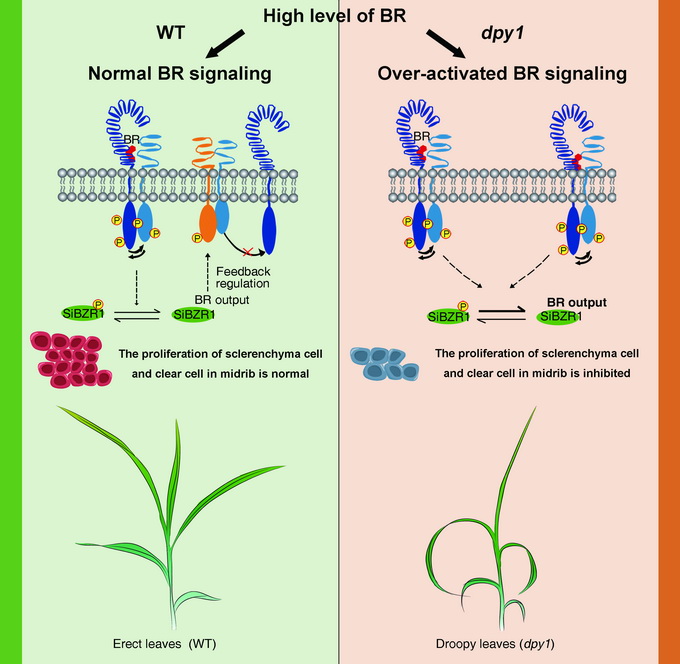- Home >> News&Events >> Events
Scientists Identify Modulator of Plant Architecture in Setaria
The leaf is the primary organ for the capture of light and organic compound synthesis in plants. For cereal crops, leaf architectureis an important agronomic trait that directly determines canopy structure, as well as grain yield.
Foxtail millet (Setaria italica, 2n=18), originated from northern China, is still one of the staple cereals grown in China, and other Asian countries. It belongs to C4 cereals in subfamily Panicoideae and typically produce large and long leaf blades for efficient capture of light and photosynthesis but the leaves droop downward, particularly at the adult stage, thus, adversely affecting canopy structure and grain yield. Identification of key regulators that control leaf droopiness is crucial to improve plant architecture in these crops.
In a recent study published in PNAS, the researchers from the Center for Agricultural Resources Research, Institute of Genetics and Developmental Biology, Chinese Academy of Sciences, together with their collaborators from the Institute of Crop Sciences, Chinese Academy of Agricultural Sciences, revealed that DROOPY LEAF1 (DPY1), a novel regulator of BRASSINOSTEROID-INSENSITIVE1 (BRI1)/BRI1-ASSOCIATED KINASE1 (BAK1) interaction, prevents Brassinosteroid (BR) signaling from overactivation in response to high doses of BRs to ensure that the long leaf blades grow upward in Setaria.
The researchers observed that loss-of-function mutation in DPY1 led to malformation of vascular sclerenchyma and low lignin content in leaves, and thus, an extremely droopy leaf phenotype, consistent with its preferential expression in leaf vascular tissues. Through a series of biochemical experiments, they found that DPY1 interacts with and competes for SiBAK1 and as a result, causes a sequential reduction in SiBRI1/SiBAK1 interaction, SiBRI1 phosphorylation, and downstream BR signaling in Setaria. Conversely, DPY1 accumulation and affinity of the DPY1/SiBAK1 interaction are enhanced under BR treatment, thus preventing SiBRI1 from overactivation. As such, those findings reveal a negative feedback mechanism that represses leaf droopiness by preventing an over-response of early BR signaling to excess BRs.
Finally, they demonstrated that plants overexpressing DPY1 have more upright leaves, thicker stems, and bigger panicles, suggesting potential utilization for yield improvement. The maize ortholog of DPY1 rescues the droopy leaves in dpy1, suggesting its conserved function in Panicoideae.
Their findings provide insights into how BR signaling is scrutinized by DPY1 to ensure the upward leaf architecture, which will help plant architecture improvement in cereals.
The paper entitled "DROOPY LEAF1 Controls Leaf Architecture by Orchestrating Early Brassinosteroid Signaling” was published online in PNAS (doi:10.1073/pnas.2002278117) on August 17, 2020.
The research was supported by National Key Research and Development Program of China, the National Natural Science Foundation of China, Science and Technology Service Network Initiative of Chinese Academy of Sciences.

